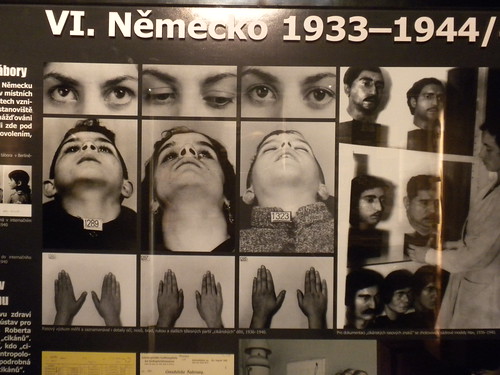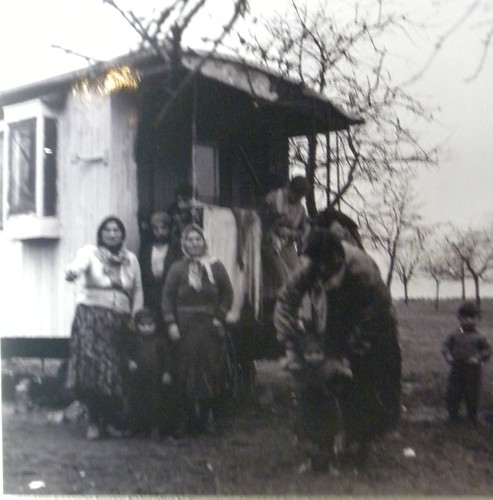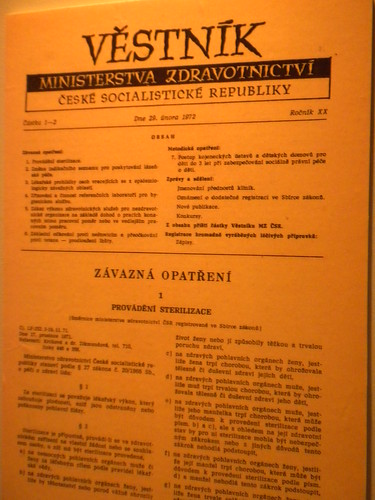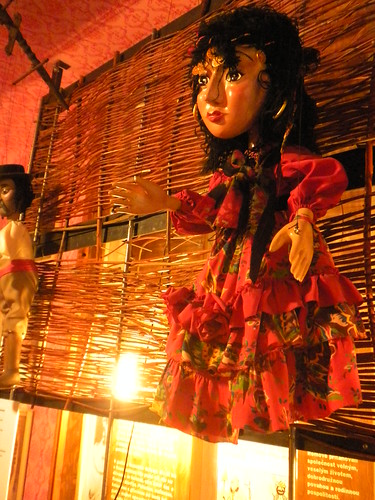What a busy few weeks! The quilt is starting to shape up as the women complete their panels and get better every day at embroidery. I have been busy asking them questions and taking lots of pictures and videos, and have created preliminary profiles of the women who have put so much effort into this project! Visit the blog I made to host such information, and read the stories of the women under the post “Meet the Quilters: Mimon, Czech Republic.”
However, another blog on the quilt will happen later, as I want to tell everyone about my visit to the Museum of Romani Culture in Brno!
Located in a historically Roma neighborhood, the Roma Culture Museum in Brno is a small space in which a lot of information is displayed. Past Fellows have visited the museum, including my immediate predecessor, Tereza Bottman, who had the opportunity to meet with the founder, Karel Holomek and his daughter and fellow activist Dr. Jana Horváthová.
Although I did not get to meet with the museum’s founders, I was led around the main exhibition by curator and historian Michal Schuster. Although a non-Roma individual, he was extremely knowledgeable and passionate about the museum and its causes.
The museum’s permanent exhibition is a journey through the history of the Roma people throughout Czechoslovakia from the beginning of WWII until present day. Mr. Schuster told me that they are currently working on expanding the exhibit, including the migration of the Roma people from the Indian subcontinent all the way up until the second World War.
The first room we entered was plastered with imagery from the era of WWII, when there was no Czechoslovakia; just the protectorates of Bohemia and Moravia and the country of Slovakia, and ally of Nazi Germany. The room had tiled walls, and was created to resemble a shower in which hundreds of thousands of innocent people were killed during the Holocaust. It brought chills to my spine, after visiting Auschwitz-Birkenau last spring, I am all too aware of the reality of what happened to the millions killed during this time.

Eugenic analysis of Roma people by Nazi "scientists". Races were decided by the size of one's nose, how far apart their eyes were, and other arbitrary classfications.
The next room chronicles the history of the Roma in Czechoslovakia after WWII and into the Communist era. The museum details the “assimilation” process enforced by the Communist authorities, in which Roma people were stripped of the nomadic lifestyle, and forced to integrate into “white” society. Many traditions and customs were forgotten as people worked to survive under the new regime, especially after the Soviet invasion after 1968’s Prague Spring.

Photograph of a traditional Roma family outside of their caravan. The Communist Regime banned the nomadic lifestyle of Roma and forced assimilation on people of all ethnicities.
But before the invasion, the Roma society was as swept up in the liberal ideals and artistic expansion under Prague Spring as the rest of the population. During this time there was the creation of the Union of Gypsy Roma, the first organization to talk with the regime about rights. They produced magazines, detailed athletic achievements of Roma, and promotes Roma art and music.
They were closed in 1973 after the Soviet Invasion, and from that point on the situation became even more dire for the Roma population. Sterilization reached it’s height during the 1980’s, in which many Roma women were coerced into being sterilized after giving birth to their child. After labor a doctor would offer them money to be sterilized. Not knowing what that would mean and only understanding that they would get more money to support their family, they agreed. Only recently have these violations of human rights been admitted by the Czech and Slovak governments.

This is one of the first documents to mention sterilization as a means of population control. Although Roma are not specifically mentioned in this document, they suffered the most from this practice.
In 1989 there was the famous Velvet Revolution, and during that time there was an uprising of Roma culture and society. The museum details all the new art and music which was produced during this era, and has exhibits which profile musicians and artists, as well as having original artwork by Roma artists on display.
An additional section is reserved for non Roma interpretations of Roma culture – the stereotypes which society has produced and enforced throughout the years. Stereotypes from the opera Carmen to the stereotypical “Gypsy fortune teller,” are presented, all of which seem absurd when sitting among the numerous cultural artifacts housed in the museum.

This puppet is designed to represent a "typical" Roma woman - gold jewelry, dark hair, and flowing skirt.
The last room is a collection of news articles from the establishment of the Czech Republic in 1992 until present day. The euphoria present after the fall of Communism is soon wiped out by a wave of far right extremism and neo-Nazism in the mid 90’s. The more recent articles show the slow progress of the Roma movement, but are hopeful reminders of what the future could be like. One of the articles Mr. Schuster pointed out to me was about a Roma man who won a popular singing show (think American Idol – but in the Czech Republic.)
The middle of this room holds a large, rotating wheel, upon which hang three panels. On these panels are news articles which propagate stereotypes and prejudices, labeling Roma as criminals, as people who refuse to assimilate, as lazy, and the numerous other stereotypes which are thrown at the Roma population by the mass media.
Although this was a rather long blog post, I hope it inspires some people to take a look at the museum’s webpage and think about how culture can be used as a tool for inclusion rather than exclusion. Perhaps once people start accepting the beauty of Roma music, art, and many traditions, it will allow the Roma population to stop suffering such extreme discrimination.
Posted By Beth Wofford
Posted Jul 28th, 2011


3 Comments
iain
July 28, 2011
Really interesting! Great historical overview, and sets up your own work with the Roma women and their quilt – your own contribution to inclusive Roma culture!
Martha-ann Smith
July 30, 2011
Very interesting reading. Looking forward to reading your blog related to your journeys. I am your dad’s first cousin. I live in Northwest Georgia, in the county where he grew up. I just found him on Facebook. I just retired from teaching High School.We studied some on this country. Take care, and I pray God’s blessings on your work there. Martha-ann Smith
Beth Wofford
July 30, 2011
Thanks for reading! I hope the rest of the blog is interesting with your knowledge of the country. Have a wonderful weekend!